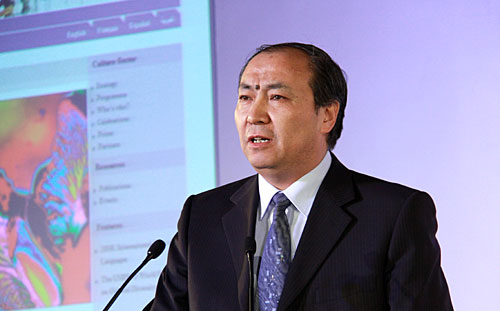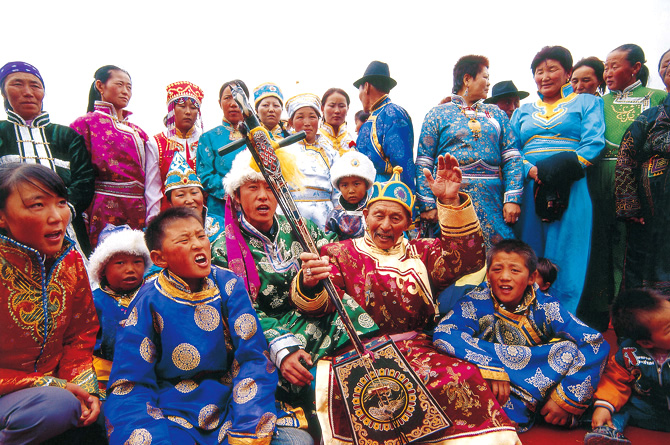Advocate for Chinese perspectives on epic studies

Chao Gejin, a CASS Member, director of and a research fellow from the Institute of Ethnic Literature at CASS

Together with Gesar and Manas, Jangar is a globally renowned Mongolian heroic epic in China. Jangar is widely sung by local people, and this oral transmission has been passed down through generations. Assisted by multimedia, it will become much easier to process the narrative of oral epics. The picture shows Mongolian performers singing Jangar accompanied with Morin Khuur (horse-head fiddle).
Chao Gejin (1958- ) is the director of and a research fellow from the Institute of Ethnic Literature at the Chinese Academy of Social Sciences (CASS) and a CASS Member. He serves as the president of both the International Council for Philosophy and Human Sciences, known by its French initials CIPSH, and the International Society for Epic Studies. He specializes in folklore, the theory of folk literature and Chinese minority literature. His representative works include Oral Epic Poetics.
Though he holds a series of domestic and international academic titles, Chao Gejin is by no means a pedantic expert. Actually, he not only conducts field investigation in China’s rural areas to look for folk artists but also goes abroad to introduce Chinese ideas and cultural traditions to the world, and his achievements have been recognized by international academia.
In 2014, the General Assembly of the CIPSH elected Chao to be its new president at UNESCO in Paris. Chao is the first scholar from the Chinese mainland to serve as the president of such a high-level international academic institution. Recently, CSST sat down with Chao to talk about trends and developments of China’s epic studies.
CSST: Take epic studies as an example. So how do the humanities develop international dialogues? What kind of international standing does China’s epic studies have at the present?
Chao: In order to answer this question, we must ponder the matter deeply. In the West, epic studies and classical studies are closely connected, and abundant work and talent are dedicated to the field of epic studies. In the setting of Western college arts curriculum, classes about epic studies have become indispensable. In general, starting from ancient Greek to the Renaissance and then the contemporary West, international epic studies has had a long history. Moreover, practitioners in the field of epic studies have strong critical thinking skills, and new theories and genres are constantly emerging, profoundly influencing many other relevant disciplines.
Comparatively speaking, China’s epic studies started rather late, and there are few research experts. Starting in the 1980s to the early 1990s, a research team on epic studies gradually began taking shape. But in recent years, China’s epic studies has progressed by leaps and bounds. There is high enthusiasm, and there have been numerous achievements. As a whole, building databases, processing data, conducting fieldwork, publishing theoretical articles and multiple other steps of China’s epic studies advance together, and it carries out a vivid dialogue with international academia. At the moment, the number of publications on China’s epic studies has exceeded 2,000, and most of them were published in recent years.
China’s epic studies provides new inspiration for international academia. For instance, China’s southern minorities have been recognized for studies on creation epics and origination epics, which are now used as a new reference for the classification of international epics.
CSST: In those database establishments you engaged in, which project has left the greatest impression on you?
Chao: Under the general framework of video and image database for minorities, now we adopt advanced ideas and take steps to carry out the establishment of mythology and epic databases for minorities. Let me take Mongolian epics as an example. The Institute of Ethnic Literature at the Chinese Academy of Social Sciences (CASS) has accumulated a considerable amount of data. Some of the data are purchased from foreign libraries’ oriental literature storage but most of them are “saved” by us. On the list of singers of our music library, many of their names are printed in black frames which indicate they have passed away, and many of their classical folk performances have become their final recording. It indicates that much precious cultural heritage in the folk has died out at a high speed. Since the 1990s, the Institute of Ethnic Literature, the first one in China, has set about collecting and organizing folk cultural documents and today still ranks among the best. Through everyone’s great efforts, we have accumulated many folk cultural resources that would otherwise have been lost.
CSST: From your perspective, what changes does big data bring to studies on human sciences?
Chao: The concept of big data will have a revolutionary impact on studies on humanities. Certainly, it poses a great challenge for technology. But from the perspective of the convenience of science and technology, nothing can be compared to big data. For instance, the paper Series of Mongolian Heroic Epics has four volumes and it is so difficult for readers to look through. But when it is transformed into an e-book, it can be stored in a flash drive. Compared to holding a book in both hands, reading an e-book is much more convenient. Besides, the e-book includes some labels to identify key data, such as epics’ personage introduction, geographical distribution and plot structure. So it becomes very convenient to efficiently extract data segments for analysis.
As a general rule, practitioners in humanities are not interested in electronic data. But I have taken charge of or participated in the project of databases in recent years. Not only am I passionate about the combination of humanities and electronic technology but also I find out that electronic technology’s applicability in humanities exceeds expectations. For example, processing e-texts of literature studies will lead to many amazing conclusions. The confirmation of right of authorship of And Quiet Flows the Don, discussions of capital taste (known as Jing Weier, referring to Beijingers’ traditional culture) in Lao She’s (1899-1966) novels and an examination of parallel format in Yugoslavian and Turkic epics all would be impossible without electronic technology.
Because Mongolian poetry is alliterative, it is incomparably convenient to process lines of poetry and observe alliteration and rhyme of poetry using a computer. This is just a low-level application of electronic technology. Moreover, electronic retrieval can generally grasp large-scale folk narratives, such as types and subtypes of epics, analysis of personage relationship and conclusion of relevance of all factors in stories. So it becomes so easy to summarize “rules” of folk narratives. In the first half of the 20th century, Vladimir Propp’s morphology study of folktales was based on exhaustive reading and induction, and the notebooks required for recording essential data numbered more than a dozen. If his study could be conducted today, then we could establish databases of Russian magic stories. Just by choosing data segments and labels and analyzing on the computer, we would get double the results.
In addition, a segment of an epic narrative may be accompanied by a group dance and some patterns and ornamentations or based on a ritual activity. By taking advantage of multimedia technology to process such a segment, the result would be enhanced. Some oral folk art, such as narrative poems, may form an interesting intertextual relation with other literature genres, like proverbs, legends and congratulatory speeches. Many expression “units”—patterns of words and phrases, typical scenes and others—appear repeatedly in various narrative patterns, and we cannot imagine how to possibly deal with such large-scale texts without electronic technology. Thus it can be seen that electronization, multimedia and establishment of databases will play a significant role in academic development of human sciences in the future.
CSST: What characteristics does China’s intangible cultural heritage conservation have?
Chao: China’s intangible cultural heritage conservation is led by the government, but it also involves academics and the participation of the masses. In this pattern, academia plays a leading role and a driving force in cooperating with government, introducing international ideas and fostering public enthusiasm. I feel proud to engage in such a great job to protect China’s intangible cultural heritage. The reason why China’s intangible cultural heritage conservation can gain renown at the international level is that Chinese academics can both understand international ideas for intangible cultural heritage conservation and, on the basis of national conditions, explore a conservation method suited to China’s forms of state and government as well as the mindset of the masses.
LU Sha is a reporter at the Chinese Social Sciences Today.

 PRINT
PRINT CLOSE
CLOSE